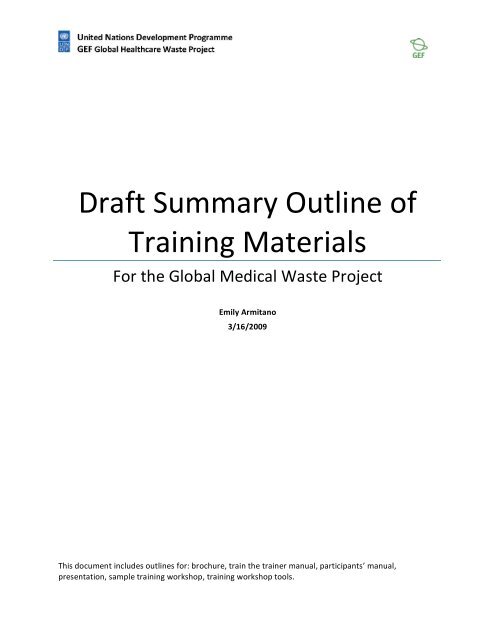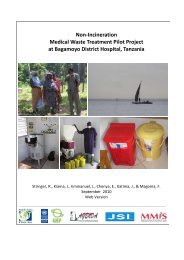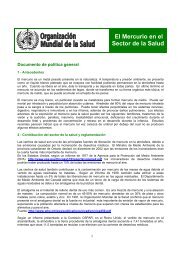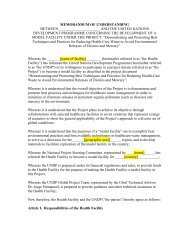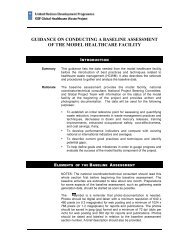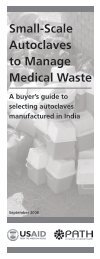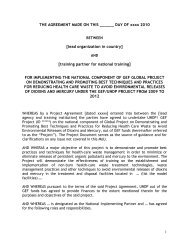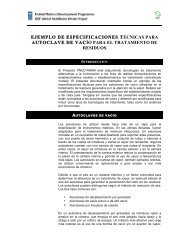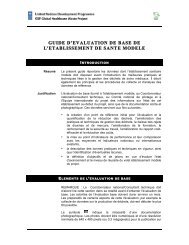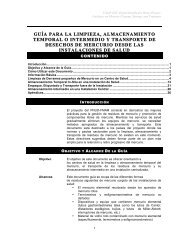Compilation of - UN/GEF Global Healthcare Waste Project
Compilation of - UN/GEF Global Healthcare Waste Project
Compilation of - UN/GEF Global Healthcare Waste Project
You also want an ePaper? Increase the reach of your titles
YUMPU automatically turns print PDFs into web optimized ePapers that Google loves.
<br />
<br />
<br />
Draft Summary Outline <strong>of</strong> <br />
Training Materials <br />
For the <strong>Global</strong> Medical <strong>Waste</strong> <strong>Project</strong> <br />
<br />
Emily Armitano <br />
3/16/2009 <br />
<br />
<br />
This document includes outlines for: brochure, train the trainer manual, participants’ manual, <br />
presentation, sample training workshop, training workshop tools.
<br />
<br />
Contents <br />
<br />
BROCHURE: informational with an overview <strong>of</strong> the program, certificate training ...................... 3 <br />
GENERAL Train the Trainers Manual or Facilitators Guide............................................................. 4 <br />
GENERAL Participants Manual - printed training manuals topics overview for healthcare waste<br />
management .................................................................................................................................................. 6 <br />
GENERAL Presentations Outline........................................................................................................... 12 <br />
SAMPLE Training Health Care <strong>Waste</strong> Management Workshops .................................................... 14 <br />
<br />
Training Workshop Tools and Suggestions (Developed by Gina).........Error! Bookmark not defined. <br />
<br />
2 <strong>UN</strong>DP <strong>GEF</strong> <strong>Global</strong> <strong>Healthcare</strong> <strong>Waste</strong> <strong>Project</strong>: <br />
Draft Summary Outline <strong>of</strong> Training Materials <br />
<br />
<br />
<br />
BROCHURE: informational with an overview <strong>of</strong> the program, certificate training <br />
<br />
• Title page, including location and partners <br />
• About the Institution and program providing the training <br />
• Certificate context/need, objectives, beneficiaries, program package <br />
• Detailed program design (for example): <br />
o Definitions <br />
o Facility Policies and Procedures <br />
o Storage and Containment <br />
o Labeling <br />
o Generator Requirements <br />
o Treatment <br />
o Health care <strong>Waste</strong> Transport <br />
o Alternative technologies <br />
o Treatment and Disposal Facilities <br />
o Treatment Facilities Requirements <br />
o Disposal Facility Requirements <br />
o Accountability <br />
o Health and Safety <br />
• Admission information, including fees, eligibility, duration, and sessions <br />
• Credit System <br />
• Implementation plan <br />
• Evaluation <br />
• For further information contact <br />
<br />
3 <strong>UN</strong>DP <strong>GEF</strong> <strong>Global</strong> <strong>Healthcare</strong> <strong>Waste</strong> <strong>Project</strong>: <br />
Draft Summary Outline <strong>of</strong> Training Materials <br />
<br />
<br />
GENERAL Train the Trainers Manual or Facilitators Guide <br />
<br />
1. Introduction (examples below): <br />
• Purpose: The Facilitators’ Guide provides information, strategies and activities for the facilitator <br />
and is designed to emphasize key points during training sessions: <br />
o To raise awareness <br />
o To provide information <br />
o To identify waste management practices and technologies <br />
o To enable managers to develop their waste management plans <br />
o To enable course participants to develop training programs <br />
• How to use the Facilitators Guide <br />
• Objectives <strong>of</strong> the course <br />
• Principles <strong>of</strong> Effective Communication <br />
• 50 (some number) <strong>of</strong> useful tips for trainers <br />
2. Identifying training needs (examples below): <br />
• What is training <br />
• Why Train <br />
• Possible sources <strong>of</strong> training needs <br />
• Identifying training needs <br />
• Clarifying intended learning outcomes <br />
• How to identify the target group ‐ Who are the Likely Learners <br />
• Setting objectives – what training staff for (examples below): <br />
o Good health care waste management practices <br />
o <strong>Waste</strong> minimization <br />
o observe universal precautions for infection control <br />
o Handling, segregation, storage and labeling <br />
o Transport, disposal and treatment <br />
o Proper record keeping <br />
3. Training design: elements to consider if you decide to organize a new training event, planning the <br />
course program (examples below): <br />
• Identifying training resources <br />
• selection <strong>of</strong> trainers and experts <br />
o a good trainer is someone who is a good communicator <br />
o a nurse or doctor from the same hospital who can speak in local dialect <br />
• Interpretation <br />
• Selection <strong>of</strong> materials and resources <br />
o written materials <br />
o web‐based resources <br />
• key training design questions <br />
• putting the training programme together <br />
4. Practical Issues – training hospital workers (examples below): <br />
• Establishing the best learning environment <br />
o How doctors learn <br />
o How nurses learn <br />
o How hospital workers learn <br />
4 <strong>UN</strong>DP <strong>GEF</strong> <strong>Global</strong> <strong>Healthcare</strong> <strong>Waste</strong> <strong>Project</strong>: <br />
Draft Summary Outline <strong>of</strong> Training Materials <br />
<br />
• Timing <br />
• making the trainees feel at ease <br />
• establish appropriate ground rules <br />
5. Methodology (examples below): <br />
• adult learning principles‐ Critical Elements <strong>of</strong> Learning <br />
• role <strong>of</strong> the trainer <br />
• barriers to effective training <br />
6. Training techniques (examples below): <br />
• Methods <strong>of</strong> Teaching <br />
• group work <br />
• Gaining audience interaction: participatory techniques <br />
• Running a case study <br />
• Writing a case study <br />
• Running a role play <br />
• writing a role play <br />
• conducting report back session <br />
• Presentations <br />
• The problem solving approach to learning <br />
7. Training materials/teaching aids (examples below): <br />
• Audio‐visual <br />
o why do we use audio‐visual aids in presentations <br />
o PowerPoint and overhead projectors/slides <br />
o videos and DVDs <br />
o Flipcharts, posters <br />
• Handouts: bags, bleach, containers, protective gear <br />
8. Feedback and evaluation (examples below): <br />
• why seek feedback <br />
• giving feedback to trainees <br />
• giving feedback to trainers and training institutes <br />
• identifying future training needs <br />
• disseminating the lessons from training <br />
9. Sample training workshops – Course Resources (these are modules with examples <strong>of</strong> organization <br />
below): <br />
• duration <br />
• training materials <br />
• methodology <br />
• expected outcomes <br />
• facilitator activities <br />
• evaluation <br />
<br />
<br />
<br />
<br />
<br />
<br />
5 <strong>UN</strong>DP <strong>GEF</strong> <strong>Global</strong> <strong>Healthcare</strong> <strong>Waste</strong> <strong>Project</strong>: <br />
Draft Summary Outline <strong>of</strong> Training Materials <br />
<br />
<br />
GENERAL Participants Manual ‐ printed training manuals topics overview for <br />
healthcare waste management <br />
<br />
Course Introduction – provides context, learning expectations, and outcomes <br />
• Purpose and learning objectives <br />
• Audience <br />
o Training <strong>of</strong> doctors <br />
o Training <strong>of</strong> nurses <br />
o Training <strong>of</strong> hospital staff <br />
• How to use these materials <br />
• Description <strong>of</strong> training materials <br />
• Introduction to Learning blocks ‐ explanation for order and topics <strong>of</strong> learning blocks or elements <br />
• Adaptation: adapting these training materials for your program <br />
• <br />
Block 1: Fundamentals: Environment and Health, Health Care <strong>Waste</strong>, Management Regulations <br />
a. Introduction to Environment: Information, activities, quotes from famous people and leaders, good <br />
descriptive graphics. Examples below: <br />
• Learning Objectives <br />
• Introduction <br />
• What is Environment? <br />
• Features <strong>of</strong> Our Environment <br />
• Ecosystem <br />
• Food and Energy Flow <br />
• Matter Cycles <br />
• Population and Community <br />
• Energy <br />
• Pollution and Pollutants <br />
• Let Us Sum Up <br />
• Key Words <br />
• Further Readings <br />
b. Environmental Pollutants: Information, activities, quotes from famous people and leaders, good <br />
descriptive graphics. Examples below: <br />
• Learning Objectives <br />
• Introduction <br />
• Historical Development <br />
• Air Pollution <br />
• Noise Pollution <br />
• Water Pollution <br />
• Radiation Pollution <br />
• <strong>Global</strong> Issues <br />
• Let Us Sum Up <br />
• Key Words <br />
• Further Readings <br />
<br />
6 <strong>UN</strong>DP <strong>GEF</strong> <strong>Global</strong> <strong>Healthcare</strong> <strong>Waste</strong> <strong>Project</strong>: <br />
Draft Summary Outline <strong>of</strong> Training Materials <br />
<br />
c. Interrelationship <strong>of</strong> Environment and Health: Information, activities, quotes from famous people and <br />
leaders, good descriptive graphics. Examples below: <br />
• Objectives <br />
• Introduction <br />
• Concept and Definition <strong>of</strong> Health <br />
• Dynamics <strong>of</strong> Development <strong>of</strong> Disease <br />
• Environment and its Effect on Health <br />
• Let Us Sum Up <br />
• Key Words <br />
• Further Readings <br />
d. <strong>Waste</strong> Management: Information, activities, quotes from famous people and leaders, good <br />
descriptive graphics. Examples below: <br />
• Objectives <br />
• Introduction <br />
• <strong>Waste</strong> Around Us <br />
o Definition and Identification: hospital, medical, clinical, pathological, infectious, sharps, <br />
chemical, etc. <br />
o Streams <strong>of</strong> waste production <br />
o Classification <strong>of</strong> <strong>Waste</strong>s <br />
o Characterization <strong>of</strong> <strong>Waste</strong>s and its Importance <br />
• Principles <strong>of</strong> <strong>Waste</strong> Management <br />
o Collection and Segregation <br />
o Recycle, Recovery and Reuse <br />
o Transportation, Treatment and Disposal <br />
• <strong>Waste</strong> Disposal Versus <strong>Waste</strong> Management <br />
o General introduction to waste treatment technologies <br />
• Let Us Sum Up <br />
• Key Words <br />
• Further Readings <br />
<br />
Block 2: Health Care <strong>Waste</strong> Management <br />
a. Block Introduction – provides context, learning expectations, and outcomes <br />
b. Definition, Types and Categories <strong>of</strong> <strong>Waste</strong>. Examples below: <br />
• Objectives <br />
• Introduction <br />
• Definition <strong>of</strong> <strong>Waste</strong> <br />
o Municipal <strong>Waste</strong> <br />
o Health Care <strong>Waste</strong> <br />
o Sources <strong>of</strong> Health Care <strong>Waste</strong> <br />
• Types <strong>of</strong> Health Care <strong>Waste</strong> <br />
• Categories <strong>of</strong> Health Care <strong>Waste</strong> <br />
• <strong>Waste</strong> Audit – how to do this? <br />
• Let Us Sum Up <br />
• Key Words <br />
• Further Readings <br />
c. Principles <strong>of</strong> Health Care <strong>Waste</strong> Management. Examples below: <br />
• Objectives <br />
<br />
7 <strong>UN</strong>DP <strong>GEF</strong> <strong>Global</strong> <strong>Healthcare</strong> <strong>Waste</strong> <strong>Project</strong>: <br />
Draft Summary Outline <strong>of</strong> Training Materials <br />
<br />
• Introduction <br />
o Policies, Laws and Guidelines Related to HCWM <br />
• General Principles <strong>of</strong> <strong>Waste</strong> Management <br />
o Do No Harm <br />
o Disposables versus Durables (Non‐disposables) <br />
o Reduce, Recycle, Reuse and Recover <br />
o Flow <strong>of</strong> <strong>Waste</strong> <br />
• Principles <strong>of</strong> Managing Different Categories <strong>of</strong> <strong>Waste</strong> <br />
o Principles <strong>of</strong> Managing Sharps <br />
o Chemical Disinfectants <br />
o <strong>Waste</strong> from Dental Clinics <br />
o <strong>Waste</strong> from Laboratories and Blood Banks <br />
o <strong>Waste</strong> from Other Patient Care Areas <br />
o Radioactive <strong>Waste</strong> <br />
o Expired Pharmaceuticals <br />
o Attenuated Vaccines <br />
• Principles <strong>of</strong> <strong>Waste</strong> minimization and recycling <br />
• Principles <strong>of</strong> Segregation, Collection, and Transportation <strong>of</strong> Health Care <strong>Waste</strong> <br />
• Principles <strong>of</strong> Treatment <br />
o Incineration hazards <br />
o Alternative Technologies <br />
• Principles <strong>of</strong> Disposal <strong>of</strong> Health Care <strong>Waste</strong> <br />
• Principles <strong>of</strong> Accident Reporting and emergency contingency planning <br />
• Occupational Hazards Due to Biomedical <strong>Waste</strong> <br />
• Let Us Sum Up <br />
• Key Words <br />
• Further Readings <br />
d. Handling Health Care <strong>Waste</strong>. Use <strong>of</strong> flow chart. Examples below: <br />
• Objectives <br />
• Introduction <br />
• Source Identification <br />
o Point Sources <strong>of</strong> <strong>Waste</strong> Generation <br />
o Area and Sources <strong>of</strong> <strong>Waste</strong> Generation <br />
• Attitudinal Change—Concept <strong>of</strong> Clean and Unclean Practices & General Rules for handling waste <br />
o Hazards <strong>of</strong> <strong>Waste</strong> <br />
o Preventing Infections <br />
o Hand Washing <br />
o Use <strong>of</strong> Gloves <br />
o Use <strong>of</strong> Disinfectants and procedures <br />
o House Keeping <br />
o Record Keeping <br />
o Duties <strong>of</strong> Employees <br />
• Segregation, Collection, Transportation and Disposal <br />
o Segregated Collection <br />
o Storage, containers, labeling <br />
o Transportation Chain <br />
o Final Treatment <br />
<br />
8 <strong>UN</strong>DP <strong>GEF</strong> <strong>Global</strong> <strong>Healthcare</strong> <strong>Waste</strong> <strong>Project</strong>: <br />
Draft Summary Outline <strong>of</strong> Training Materials <br />
Incineration (advantages/disadvantages) <br />
Non‐incineration technologies(advantages/disadvantages) <br />
• Thermal <br />
o Autoclave <br />
o Microwave <br />
o Steam <br />
o Dry heat <br />
• Chemical <br />
o Non‐chlorine <br />
• mechanical <br />
o Disposal Methods <br />
• Management and handling <strong>of</strong> specialized waste <br />
o Management <strong>of</strong> Sharps <br />
o Management <strong>of</strong> Metal Sharps <br />
o Management <strong>of</strong> Glass Sharps <br />
o Management <strong>of</strong> Plastics <br />
o Management <strong>of</strong> Liquid <strong>Waste</strong> <br />
o Management <strong>of</strong> Chemical <strong>Waste</strong> <br />
o Management <strong>of</strong> Soiled Linens <br />
o Infectious <strong>Waste</strong> Management <br />
• Let Us Sum Up <br />
• Key Words <br />
• Further Readings <br />
<br />
Block 3: Need for a Sound Health Care <strong>Waste</strong> Management <br />
a. Block Introduction – provides context, learning expectations, and outcomes <br />
b. Impact <strong>of</strong> Health Care <strong>Waste</strong> on our Environment: uses case studies. Examples below: <br />
• Objectives <br />
• Introduction <br />
• Chemicals in Health Care <strong>Waste</strong> <br />
o Mercury <br />
o Dioxin <br />
• Impact on Environment <br />
o Effect on Atmosphere <br />
o Impact on Food and Livestock <br />
o Impact on Water and Aquifer <br />
o Impact on Marine Ecosystem <br />
• <strong>Healthcare</strong> <strong>Waste</strong> Management Planning for Health Facilities <br />
• Let Us Sum Up <br />
• Key Words <br />
• Further Readings <br />
c. Impact <strong>of</strong> Health Care <strong>Waste</strong> on Human Health. Examples below: <br />
• Objectives <br />
• Introduction <br />
• Effects <strong>of</strong> Physical Pollutants <br />
• Effects <strong>of</strong> Chemical Pollutants <br />
• Effects <strong>of</strong> Biological Pollutants <br />
<br />
<br />
9 <strong>UN</strong>DP <strong>GEF</strong> <strong>Global</strong> <strong>Healthcare</strong> <strong>Waste</strong> <strong>Project</strong>: <br />
Draft Summary Outline <strong>of</strong> Training Materials <br />
• Effects <strong>of</strong> Radiological Pollutants <br />
• Sources <strong>of</strong> Infectious Agents in Health Care <strong>Waste</strong> <br />
• Susceptibility, Risk and Impact <strong>of</strong> Health Care <strong>Waste</strong> on Health Providers <br />
• Let Us Sum Up <br />
• Key Words <br />
• Further Readings <br />
d. Worker Safety and Precautions. Examples below: <br />
• Objectives <br />
• Introduction <br />
• Safety and Precautions <br />
o Principles <strong>of</strong> Safe Handling <br />
o Occupational Safety <br />
o Safety Precautions for Doctors, Nurses, Paramedical and for <strong>Waste</strong> Handlers <br />
o Emergency Planning <br />
• Job Responsibilities in HCWM(Roles and Responsibilities): <br />
o Medical Officer in Charge <strong>of</strong> Hospital <br />
o <strong>Healthcare</strong> <strong>Waste</strong> Management Team <br />
o <strong>Healthcare</strong> <strong>Waste</strong> Management Officer <br />
o Head <strong>of</strong> Administration <br />
o Patron/Matron <strong>of</strong> Hospital <br />
o Head <strong>of</strong> operations and maintenance <br />
o Cleaning Staff <br />
o Autoclave Operator <br />
o Incinerator Operator <br />
o Landfill/waste pit Staff <br />
e. Action plan for implementing a waste management plan (examples): <br />
• Objectives <br />
• Introduction <br />
• Need <br />
• Procedure <br />
o Appointment <strong>of</strong> waste manager <br />
o Appointment <strong>of</strong> infection control committee <br />
o Defining roles/responsibilities <br />
o Creation <strong>of</strong> policy <br />
o Development <strong>of</strong> guidelines <br />
o Development <strong>of</strong> training <br />
o Immunization <br />
• Elements <strong>of</strong> a waste management plan (flow chart example): <br />
o <strong>Waste</strong> minimization <br />
o Separation <br />
o <strong>Waste</strong> identification <br />
o <strong>Waste</strong> handling <br />
o <strong>Waste</strong> treatment <br />
o Record keeping <br />
o Let Us Sum Up <br />
• Key Words <br />
• Further Readings <br />
<br />
<br />
10 <strong>UN</strong>DP <strong>GEF</strong> <strong>Global</strong> <strong>Healthcare</strong> <strong>Waste</strong> <strong>Project</strong>: <br />
Draft Summary Outline <strong>of</strong> Training Materials <br />
• Let Us Sum Up <br />
• Key Words <br />
• Further Readings <br />
<br />
Block 4: Current Status <strong>of</strong> Health Care <strong>Waste</strong> Management Legislation in the Region <br />
(country/Region/Continent) <br />
a. Block Introduction – provides context, learning expectations, and outcomes <br />
b. Rules and Legislations. Examples below: <br />
• Objectives <br />
• Introduction <br />
• Legislation in Country <br />
o Pressure Groups and Court Cases <br />
o Difficulties in Monitoring and Implementation <br />
• Evolving Legislation and Rules in Other Regional Countries <br />
• Let Us Sum Up <br />
• Further Readings <br />
• Examples <strong>of</strong> legislation <br />
c. Regulatory Mechanisms. Examples below: <br />
• Objectives <br />
• Introduction <br />
• Regulatory Authorities in Country <br />
o Role <strong>of</strong> Ministry <strong>of</strong> Environment <br />
o Role <strong>of</strong> Ministry <strong>of</strong> Health <br />
o Role <strong>of</strong> State Governments <br />
o Role <strong>of</strong> Municipal Authorities <br />
o Monitoring Mechanism <br />
• Regulatory Authorities in Other Regional Countries <br />
• International Agreements and Underlying Legislative and Regulatory Principles <br />
o The Stockholm Convention on Persistent Organic Pollutants <br />
o The Basel Convention on the Control <strong>of</strong> Transboundary Movements <strong>of</strong> Hazardous <br />
<strong>Waste</strong>s and their Disposal <br />
o Legal Provisions <br />
• Discussion <br />
• Let Us Sum Up <br />
• Key Words <br />
• Further Readings <br />
d. Current Status in Specific Country or Countries. Examples below: <br />
• Objectives <br />
• Introduction <br />
• Current Status <br />
• Country Pr<strong>of</strong>ile <br />
• Health Care in Country <br />
• Current <strong>Waste</strong> Management Practices <br />
<br />
<br />
<br />
11 <strong>UN</strong>DP <strong>GEF</strong> <strong>Global</strong> <strong>Healthcare</strong> <strong>Waste</strong> <strong>Project</strong>: <br />
Draft Summary Outline <strong>of</strong> Training Materials <br />
<br />
<br />
GENERAL Presentations Outline <br />
<br />
1. OVERVIEW and OBJECTIVES <br />
a. To prevent occupational and public exposure to the hazards <br />
b. To foster responsibility among health care workers for health care waste management <br />
c. To create awareness and educate about the risks and ways to prevent exposure <br />
2. ENVIRONMENTAL CONCERNS <br />
a. Toxic Pollutants from Medical <strong>Waste</strong> Incinerators <br />
b. Mercury <br />
c. Disease transmission <br />
3. HEALTH CONCERNS <br />
a. Community ‐ Who is at risk? <br />
4. LAWS AND REGULATIONS <br />
a. International <br />
b. National <br />
c. Hospital – do they have one? <br />
d. Principles <br />
i. Polluter pays <br />
ii. Precautionary <br />
iii. Duty <strong>of</strong> care <br />
iv. Proximity <br />
v. Cradle to grave <br />
e. Cost <strong>of</strong> compliance (this might be US‐specific) <br />
f. Where to get help <br />
5. GOOD (or SAFE) HEALTH CARE WASTE MANAGEMENT <br />
a. Obstacles to good health care waste management programs <br />
b. Guiding principles <br />
i. Prevent health care risks <br />
ii. Prevent environmental risks <br />
iii. Short term strategy <br />
iv. Long term strategy <br />
c. Roles & Responsibilities <br />
i. Staff <br />
ii. Organization <br />
iii. <strong>Waste</strong> management <strong>of</strong>ficer <br />
iv. Infection control committee <br />
v. Product selection/purchasing <br />
vi. <strong>Waste</strong> audit <br />
d. <strong>Waste</strong> Minimization Techniques <br />
i. Segregation, source reduction, reuse, recycling, composting <br />
e. Classification (includes statistics <strong>of</strong> types/amounts produced) <br />
i. Regular/General <br />
ii. Biomedical/Infectious <br />
<br />
12 <strong>UN</strong>DP <strong>GEF</strong> <strong>Global</strong> <strong>Healthcare</strong> <strong>Waste</strong> <strong>Project</strong>: <br />
Draft Summary Outline <strong>of</strong> Training Materials <br />
iii. Hazardous <br />
iv. Low‐level radioactive <br />
f. Handling <br />
i. Who is at risk? <br />
ii. General strategies: eliminate unnecessary injections, <br />
iii. Specific strategies: PPE, gloves, bags, Sharps, linen, hand washing, hygiene <br />
iv. Minimum approach <br />
g. Collection <br />
i. General strategies <br />
ii. Sharps waste management <br />
iii. Pathological waste management <br />
h. Segregation, Labeling, Color Coding <br />
i. Containers <br />
ii. Monitoring and evaluation <br />
i. Transport <br />
i. Outside the facility <br />
ii. Inside the facility <br />
j. Treatment Technologies (Comparison) <br />
i. Incineration <br />
ii. Non‐incineration treatment Technologies <br />
1. Criteria: effectiveness, on‐site, environmentally friendly, reduction in <br />
volume/mass, handles various types, simple, safe, affordable <br />
2. Thermal <br />
3. Chemical <br />
4. Irradiation <br />
5. Mechanical <br />
k. Storage <br />
l. Disposal Methods <br />
6. CONTINGENCY PLANNING: Spill containment and cleanup procedures <br />
7. DEMONSTRATION <br />
8. HEALTH PROTECTION AND SAFETY PRACTICES <br />
a. Training <br />
i. New staff & refresher courses <br />
ii. Training tools <br />
b. Immunizations <br />
c. Public Education <br />
i. Posters, handouts and verbal instructions <br />
9. ADOPTING HEALTH CARE WASTE MANAGEMENT <br />
a. Part <strong>of</strong> planning campaign <br />
10. PRESENTATION OF HEALTH CARE WASTE MANAGEMENT PLANS DEVELOPED & IMPLEMENTED IN <br />
OTHER CO<strong>UN</strong>TRIES <br />
<br />
<br />
<br />
13 <strong>UN</strong>DP <strong>GEF</strong> <strong>Global</strong> <strong>Healthcare</strong> <strong>Waste</strong> <strong>Project</strong>: <br />
Draft Summary Outline <strong>of</strong> Training Materials <br />
<br />
<br />
SAMPLE Training Health Care <strong>Waste</strong> Management Workshops <br />
<br />
Introduction: to impart the knowledge and skills <strong>of</strong> proper healthcare waste management. The concepts <br />
<strong>of</strong> behaviour change communication should be integrated accordingly. <br />
General Objectives: At the end <strong>of</strong> the training, participants will be able to (for example): <br />
• Understand the issues related to healthcare waste and explain its effect on people and the <br />
environment; <br />
• Identify laws, guidelines and policies related to healthcare waste management; <br />
• Demonstrate knowledge <strong>of</strong> proper healthcare waste management, such as waste minimization, <br />
segregation, handling and storage, transport, treatment and destruction, and final disposal, <br />
including home‐based infectious waste; <br />
• Understand their roles and responsibilities in healthcare waste management; <br />
• Develop a healthcare waste management plan. <br />
<br />
Module 1: Introduction to <strong>Healthcare</strong> <strong>Waste</strong> <br />
• Duration: 2 hours <br />
• Methodology <br />
o Lecture/Discussion; <br />
o Small group discussion. <br />
• Training Aids <br />
o Overhead projector; <br />
o Video; <br />
o Flip chart; <br />
o Marker pens; <br />
o Board; <br />
o PowerPoint presentation. <br />
• Expected Outcomes Participants are able to (examples below): <br />
o Explain the risk and hazards <strong>of</strong> healthcare waste; <br />
o Classify healthcare waste. <br />
• Facilitator/Learner Activities <br />
o Facilitator begins the training session with an overview <strong>of</strong> the topics and objectives (for <br />
example): <br />
Define “healthcare waste;” <br />
Discuss risks and hazards <strong>of</strong> healthcare waste; <br />
Classify healthcare waste (infectious and non infectious); <br />
Discuss the importance <strong>of</strong> proper waste disposal; <br />
Identify personnel to be trained. <br />
o Facilitator defines the term health care waste and explains its classification; <br />
o Facilitator divides participants into groups <strong>of</strong> 2 to 3 people, assigns them to discuss risks <br />
and hazards <strong>of</strong> health care waste and encourages them to participate actively; <br />
o Facilitator and participants discuss the importance <strong>of</strong> proper health care waste disposal; <br />
<br />
14 <strong>UN</strong>DP <strong>GEF</strong> <strong>Global</strong> <strong>Healthcare</strong> <strong>Waste</strong> <strong>Project</strong>: <br />
Draft Summary Outline <strong>of</strong> Training Materials <br />
<br />
15 <strong>UN</strong>DP <strong>GEF</strong> <strong>Global</strong> <strong>Healthcare</strong> <strong>Waste</strong> <strong>Project</strong>: <br />
Draft Summary Outline <strong>of</strong> Training Materials <br />
<br />
<br />
o<br />
Facilitator summarizes the session by providing participants with relevant answers if not <br />
covered in their discussions. <br />
o<br />
Assessment <strong>of</strong> Learning: Quiz and answer <br />
<br />
Module 2: Policies, Laws and Guidelines Related to <strong>Healthcare</strong> <strong>Waste</strong> Management <br />
• Duration: 1 hour <br />
• Methodology <br />
o<br />
Lecture/Discussion; <br />
o<br />
Small group discussion; <br />
o<br />
Quiz and answer. <br />
• Training Aids <br />
o<br />
Overhead projector; <br />
o<br />
Video; <br />
o<br />
Flip chart; <br />
o<br />
Marker pens; <br />
o<br />
Board; <br />
o<br />
PowerPoint presentation. <br />
• Expected Outcomes ‐ Participants are able to (examples): <br />
o<br />
Explain the national and local law and policy for health care waste; <br />
o<br />
Explain the international guidelines for health care waste. <br />
• Facilitator/Learner Activities <br />
o<br />
Facilitator begins with an overview <strong>of</strong> the topic and objectives (examples): <br />
<br />
National and local laws and policy guidelines related to healthcare waste <br />
management; <br />
<br />
International healthcare wastes management guidelines and policies. <br />
o<br />
Facilitator provides participants with some questions on Tanzanian laws related to <br />
health care waste; <br />
o<br />
Facilitator and participants discuss international healthcare waste management <br />
guidelines and policies; <br />
o<br />
Facilitator directs the participants’ attention to other relevant resources, especially <br />
Tanzanian laws related to HCWM and the national guidelines for HCWM. <br />
o<br />
Assessment <strong>of</strong> Learning: Quiz and answer <br />
<br />
Module 3: Key Steps in <strong>Healthcare</strong> <strong>Waste</strong> Management <br />
• Duration: 2 hours <br />
• Methodology <br />
o<br />
Lecture/Discussion; <br />
o<br />
Small group assignment; <br />
o<br />
Practical skills demonstration; <br />
o<br />
Field visits to healthcare facilities, waste pits and incinerators to observe HCWM; <br />
o<br />
Case study and role plays; <br />
o<br />
Discussion on photographs from the field visit if available. <br />
• Training Aids <br />
o<br />
Overhead projector; <br />
o<br />
Safety boxes; <br />
o<br />
Needle removal (if being used in the facility);
<br />
16 <strong>UN</strong>DP <strong>GEF</strong> <strong>Global</strong> <strong>Healthcare</strong> <strong>Waste</strong> <strong>Project</strong>: <br />
Draft Summary Outline <strong>of</strong> Training Materials <br />
<br />
<br />
o<br />
Syringes with needle attached; <br />
o<br />
<strong>Waste</strong> bins; <br />
o<br />
Colour coded liners; <br />
o<br />
Personal protective equipment (gloves, gumboots, aprons, masks and eye shields); <br />
o<br />
Video; <br />
o<br />
IEC materials; <br />
o<br />
Flip chart and marker pens; <br />
o<br />
Board; <br />
o<br />
Power Point presentation. <br />
• Expected Outcomes Participants will be able to (for example): <br />
o<br />
Explain the key steps <strong>of</strong> HCW management; <br />
o<br />
Explain waste segregation methods; <br />
o<br />
Demonstrate the use <strong>of</strong> safety boxes and explain what goes in the safety boxes; <br />
o<br />
List PPEs and explain their use; <br />
o<br />
Explain the storage and transportation <strong>of</strong> HCW; <br />
o<br />
Describe waste treatment and explain final disposal methods. <br />
• Facilitator/Learner Activities <br />
o<br />
Facilitator begins with an overview <strong>of</strong> the topic and objectives (for example below): <br />
<br />
At the end <strong>of</strong> the topic, participants should be able to discuss the key steps in <br />
HCWM which include: <br />
<br />
<strong>Waste</strong> minimization; <br />
<br />
recycling <br />
<br />
Segregation; <br />
<br />
Handling and storage; <br />
<br />
Transport; <br />
<br />
Treatment & destruction; <br />
<br />
Final disposal. <br />
o<br />
Facilitator leads a discussion on waste minimization procedures; <br />
o<br />
Facilitator and participants discuss the segregation <strong>of</strong> sharps and non‐sharps healthcare <br />
waste, including the colour coding system; <br />
o<br />
Facilitator demonstrates how to use a safety box; <br />
o<br />
Facilitator and participants discuss handling and storage <strong>of</strong> healthcare waste, <br />
demonstrate how to wear and use PPEs, how to carry a waste bin and how to replace <br />
bin liners; <br />
o<br />
Facilitator and participants discuss on‐site and <strong>of</strong>f‐site transportation systems, together <br />
with required specifications for wheelbarrows and vehicles used in transporting waste; <br />
o<br />
Facilitator and participants discuss the treatment and destruction options for healthcare <br />
waste; <br />
o<br />
Facilitator and participants discuss different options for final disposal <strong>of</strong> healthcare <br />
waste; <br />
o<br />
Participants visit healthcare facilities and ensure all steps <strong>of</strong> the HCWM process are <br />
observed. This includes visiting wards, waste pits and incinerators. (approximately 120 <br />
minutes); <br />
o<br />
Facilitator assigns participants to observe strengths and weaknesses in overall HCWM; <br />
o<br />
Participants present conclusions and recommend the way forward; <br />
o<br />
Facilitator invites participants to share personal experiences in relation to HCWM;
o Facilitator directs participants’ attention to other relevant resources, especially the <br />
national policy guideline for healthcare waste and standard and procedures for HCW. <br />
o Assessment <strong>of</strong> Learning: Quiz and answer <br />
<br />
Module 4: Home‐based HCWM <br />
<br />
• Duration: 30 minutes <br />
• Methodology <br />
o Lecture/Discussion <br />
• Training Aids <br />
o Overhead projector; <br />
o Video; <br />
o Flip chart; <br />
o Marker pens; <br />
o Board; <br />
o IEC materials; <br />
o PowerPoint presentation. <br />
• Expected Outcomes <br />
• Explain the collection <strong>of</strong> health care waste in the home‐based care setting; <br />
• Explain safe disposal <strong>of</strong> home‐based health care waste. <br />
• Facilitator/Learner Activities <br />
o Facilitator begins with an overview <strong>of</strong> the topic and objectives; At the end <strong>of</strong> this topic, <br />
participants will be able to: <br />
Discuss the interim guidelines for disposal <strong>of</strong> home‐based infectious waste, <br />
including sharps and non‐sharp. <br />
o Facilitator and participants discuss the interim guidelines for disposal <strong>of</strong> sharps homebased infectious waste; <br />
o Facilitator and participants discuss the interim guidelines for disposal <strong>of</strong> non‐sharps <br />
home‐based infectious waste; <br />
o Facilitator directs the participants’ attention to other relevant resources. <br />
o Assessment <strong>of</strong> Learning: Quiz and answer <br />
<br />
Module 5: Job Responsibilities <br />
<br />
<br />
• Duration: 2 hours <br />
• Methodology <br />
o Lecture/Discussion; <br />
o Small group discussion. <br />
• Training Aids <br />
o Overhead projector; <br />
o Video; <br />
o Flip chart; <br />
o Marker pens; <br />
o Board; <br />
o PowerPoint presentation. <br />
• Expected Outcomes Participants are able to (for example): <br />
o Explain the roles and responsibilities <strong>of</strong> different people in HCWM. <br />
17 <strong>UN</strong>DP <strong>GEF</strong> <strong>Global</strong> <strong>Healthcare</strong> <strong>Waste</strong> <strong>Project</strong>: <br />
Draft Summary Outline <strong>of</strong> Training Materials <br />
<br />
18 <strong>UN</strong>DP <strong>GEF</strong> <strong>Global</strong> <strong>Healthcare</strong> <strong>Waste</strong> <strong>Project</strong>: <br />
Draft Summary Outline <strong>of</strong> Training Materials <br />
<br />
<br />
o<br />
Worker’s health and safety and emergencies <br />
• Facilitator/Learner Activities <br />
o<br />
Facilitator begins with an overview <strong>of</strong> the topic and objectives; For example: At the end <br />
<strong>of</strong> the topic, the participants will be able to: <br />
<br />
Define the roles and responsibilities assigned to different cadre <strong>of</strong> staff involved <br />
in overall management <strong>of</strong> healthcare waste at facility level. <br />
<br />
Understand the procedures to ensure worker’s health and safety and what to <br />
do in emergencies <br />
o<br />
The facilitator discusses roles and responsibilities assigned to different cadre <strong>of</strong> staff <br />
involved in the overall management <strong>of</strong> healthcare waste at facility level; <br />
o<br />
Facilitator ask participants about duties they currently perform; <br />
o<br />
Facilitator and participants discuss roles and responsibilities assigned to different cadre <br />
<strong>of</strong> staff involved in the overall management <strong>of</strong> healthcare waste at facility level; <br />
o<br />
Facilitator summarizes the session and provides participants with relevant answers to <br />
their questions. <br />
o<br />
Assessment <strong>of</strong> Learning: Quiz and answer <br />
<br />
Module 6: <strong>Healthcare</strong> <strong>Waste</strong> Management Planning for Health Facilities <br />
• Duration: 2 hours <br />
• Methodology <br />
o<br />
Lecture/Discussion; <br />
o<br />
Small groups. <br />
• Training Aids <br />
o<br />
Overhead projector; <br />
o<br />
Video; <br />
o<br />
Flip chart; <br />
o<br />
Marker pens; <br />
o<br />
Board; <br />
o<br />
PowerPoint presentation. <br />
• Expected Outcomes <br />
o<br />
Explain the factors to be considered in making a regional HCWM plan; <br />
o<br />
Explain the steps in making a health facility HCWM plan. <br />
• Facilitator/Learner Activities <br />
o<br />
Facilitator opens the training session with an overview <strong>of</strong> the topic and objectives; <br />
<br />
Develop a healthcare waste management plan for their region if one does not <br />
exist; <br />
<br />
Develop a healthcare waste management plan for their facility/hospital. <br />
o<br />
Facilitator describes the district healthcare waste management plan; <br />
o<br />
Facilitator describes the facility healthcare waste management plan; <br />
o<br />
Facilitator divides participants into small groups <strong>of</strong> 5 from each healthcare facility and <br />
assigns them to develop a healthcare waste management plan for their facility <br />
according to the sample form provided as Appendix 4 in the Participants Manual; <br />
o<br />
Facilitator supervises the planning session done by each group. <br />
o<br />
Assessment <strong>of</strong> Learning: Quiz and answer <br />
<br />
<br />
E. Warren <br />
March 2009 Version <br />
<br />
This document was developed by the <strong>UN</strong>DP <strong>GEF</strong> <strong>Project</strong> on <strong>Healthcare</strong> <strong>Waste</strong> and may be used as a resource to improve <br />
healthcare waste management. The document is copyrighted but may be reproduced in its original unaltered form without <br />
permission for advocacy, campaigning and teaching purposes. Reproduction and distribution for commercial resale is strictly <br />
prohibited. If more than five copies are reproduced for distribution, <strong>UN</strong>DP/<strong>GEF</strong> must be notified by email at <br />
http://www.gefmedwaste.org/contactus.php. If quotations <strong>of</strong> excerpts or short passages are used, users must provide proper <br />
citation <strong>of</strong> the source. <strong>UN</strong>DP <strong>GEF</strong> does not warrant that the information contained in this document is complete and correct and <br />
shall not be liable for any damages incurred as a result <strong>of</strong> its use. <br />
<br />
<br />
19 <strong>UN</strong>DP <strong>GEF</strong> <strong>Global</strong> <strong>Healthcare</strong> <strong>Waste</strong> <strong>Project</strong>: <br />
Draft Summary Outline <strong>of</strong> Training Materials <br />


